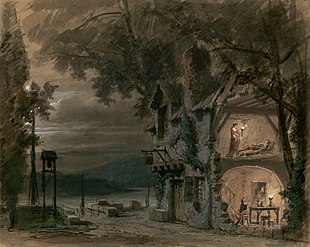Rigoletto (opera)
| Rigoletto | |
|---|---|
| Opera by Giuseppe Verdi | |

Set design by Philippe Chaperon.
|
|
| Librettist | Francesco Maria Piave |
| Language | Italian |
| Based on |
Le roi s'amuse by Victor Hugo |
| Premiere | 11 March 1851 Teatro La Fenice, Venice |
Rigoletto (pronounced [riɡoˈletto]) is an opera in three acts by Giuseppe Verdi. The Italian libretto was written by Francesco Maria Piave based on the play Le roi s'amuse by Victor Hugo. Despite serious initial problems with the Austrian censors who had control over northern Italian theatres at the time, the opera had a triumphant premiere at La Fenice in Venice on 11 March 1851.
It is considered by many to be the first of the operatic masterpieces of Verdi's middle-to-late career. Its tragic story revolves around the licentious Duke of Mantua, his hunch-backed court jester Rigoletto and Rigoletto's beautiful daughter Gilda. The opera's original title, La maledizione (The Curse), refers to the curse placed on both the Duke and Rigoletto by a courtier whose daughter had been seduced by the Duke with Rigoletto's encouragement. The curse comes to fruition when Gilda likewise falls in love with the Duke and eventually sacrifices her life to save him from the assassins hired by her father.
Verdi was commissioned to write a new opera by the La Fenice opera house in Venice in 1850. By this time he was already a well-known composer and had a degree of freedom in choosing the works he would prefer to set to music. He then asked Francesco Maria Piave (with whom he had already created Ernani, I due Foscari, Macbeth, Il Corsaro and Stiffelio) to examine the play Kean by Alexandre Dumas, père, but he felt he needed a more energetic subject to work on.
...
Wikipedia
